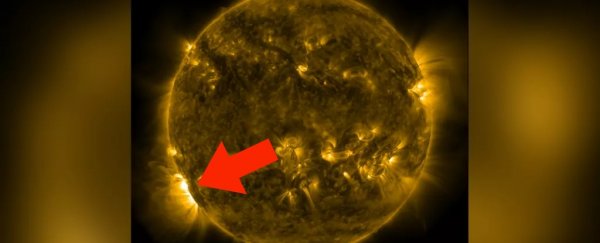A powerful solar flare just erupted from the surface of the Sun – and NASA captured stunning footage of it.
The X-class flare, the strongest produced by our star, was recorded by NASA's Solar Dynamics Observatory as it burst from a sunspot on the lower left limb of the Sun at 9:25 am EDT (13:25 GMT) on Tuesday (May 3).
Sunspots are areas on the Sun's surface where powerful magnetic fields, created by the flow of electrical charges, knot into kinks before suddenly snapping. The resulting release of energy launches bursts of radiation called solar flares and explosive jets of solar material called coronal mass ejections (CMEs).
The Sun emitted a strong solar flare on May 3, 2022, peaking at 9:25 a.m. ET. NASA’s Solar Dynamics Observatory captured an image of the event, which was classified as X-class. https://t.co/PMsgdJxMlj pic.twitter.com/PWJUI395Cc
— NASA Sun & Space (@NASASun) May 3, 2022
Related: Strange new type of solar wave defies physics
The National Oceanic and Atmospheric Administration (NOAA) classifies solar flares from A to X based on the intensity of the X-rays they release, with each level having 10 times the intensity of the last.
This flare registered as an X1.1, and is the second flare of this strength to be produced by the Sun this week. It's also the third most powerful solar flare of 2022: The star launched an X2.2 flare on April 19 and an X1.3 on March 30.
"Solar flares are powerful bursts of radiation," NASA wrote on Twitter after the event.
"Harmful radiation from a flare cannot pass through Earth's atmosphere to physically affect humans on the ground, however – when intense enough – they can disturb the atmosphere in the layer where GPS and communications signals travel."
Once they reach Earth, X-rays and ultraviolet radiation produced by solar flares ionize atoms in our upper atmosphere, making it impossible to bounce high-frequency radio waves from them and creating a radio blackout.
Radio blackouts occur over the areas lit by the Sun during the time of the flare, and they are classified from R1 to R5 according to severity.
This most recent flare caused an R3 blackout over the Atlantic Ocean, which is the same strength as the flare-induced blackout over Australia and Asia during Easter weekend last month.
Solar activity, which astronomers have known since 1775 rises and falls according to a roughly 11-year cycle, has been especially high recently, with sunspot counts nearly doubling those predicted by NOAA.
The increased activity has sent waves of high-energy plasma and X-ray bursts slamming into Earth's magnetic fields, downing Starlink satellites, triggering radio blackouts and causing auroras as far south as Pennsylvania, Iowa, and Oregon.
And the most intense activity may still lie ahead. The Sun's activity is projected to steadily climb, reaching an overall maximum in 2025, before decreasing again.
This ramp-up in activity means that, on the night of a solar storm, the aurora will be visible much farther south than usual.
This is because Earth's magnetic field gets compressed slightly by the waves of highly energetic particles, which ripple down magnetic field lines and agitate molecules in the atmosphere, releasing energy in the form of light to create colorful shifting curtains in the night sky.
Related content:
15 unforgettable images of stars
The 12 strangest objects in the Universe
9 ideas about black holes that will blow your mind
This article was originally published by Live Science. Read the original article here.
